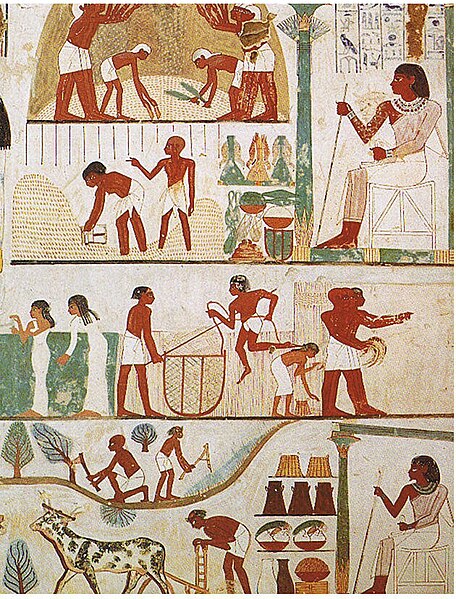
Planting and harvesting grain; ancient
Egyptian hieroglyphs
(credit: Norman de Garis Davies and Nina Davies, via Wikimedia Commons)
Agricultural societies succeeded hunter-gatherer
ones, and values such as patience, foresight, diligence, and perseverance
quadrupled in importance. These values, which farming requires, would not
replace the hunter-gatherers’ values totally and immediately, but the farmers’
values and their way of life grew until they, in their multiplying societies,
had largely made the old values obsolete. The new agricultural way of life was
just better at making more humans over more time. Population is the way to
production and then to armies and power.

Ruins of Ur, ancient Mesopotamian
city
(credit: M.Lubinski, via Wikimedia Commons)
When hard grains that could be stored indefinitely
were domesticated, towns were formed as an efficient ways to store the
community’s food wealth in a central, defensible site. Of course, the progress
from stage to stage had many recursions. Nomadic tribes with little food and
plenty of aggression to spare were lurking, and the most aggressive tribes might for a time subjugate and exploit the city dwellers. Two ways of
life tested themselves against each other. But in the end, the city dwellers
won. They had more people, more goods, weapons, and soldiers.
Inside the new cities, governing bodies with administrative
offices became necessary to ensure fair distribution of the tribe’s food and to
organize the tribe’s members in ways that brought domestic order and protection
from invaders. Following them came craftsmen and merchants who found a
protected, central site with a large population more conducive to the practice
of their arts than their old rural settings.

A potter
in action at a potter’s wheel
(credit: © Yann Forget, via Wikimedia Commons )
No comments:
Post a Comment
What are your thoughts now? Comment and I will reply. I promise.